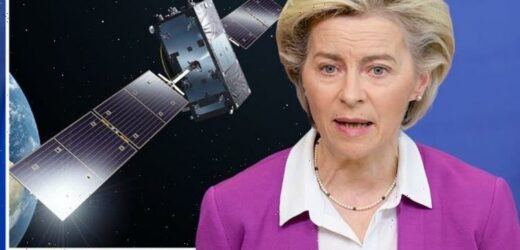Galileo: David Morris outlines UK’s role in project
We use your sign-up to provide content in ways you’ve consented to and to improve our understanding of you. This may include adverts from us and 3rd parties based on our understanding. You can unsubscribe at any time. More info
GPS or more accurately, Global Positioning System, is the US’s premier global navigation satellite system (GNSS) that is operated by the US Space Force. GPS powers everything from car satnavs to smartphones and is of particular use to armed forces and emergency responders all across the globe. The European Union (EU) boasts access to its own GNSS network, Galileo, and since the early Eighties, Russia has expanded its own GNSS network of GLONASS satellites.
Although incredibly valuable, positioning and navigation satellites have many drawbacks.
The signals can be jammed or hijacked, potentially disabling access to navigation for commercial and military devices alike.
This is why researchers at the Sandia National Laboratories in Albuquerque, New Mexico, have designed a device that could offer the benefits of GNSS but without the main security drawbacks.
The avocado-sized device uses the principles of quantum mechanics and could one day be fitted in all sorts of vehicles.


According to the researchers at Sandia, the technology has the potential to usher in a GPS-free revolution.
Bethany Little, a postdoctoral scientist working at Sandia, said: “Quantum sensors are a growing field, and there are lots of applications you can demonstrate in the lab.
“But when you move into the real world there are lots of problems you have to solve.
“Two are making the sensor compact and rugged.
“The physics takes place all in a cubic centimetre (0.06 cubic inches) of volume, so anything larger than that is wasted space.”
Brexit: Expert discusses future of Galileo space project
GPS is incredibly precise in its measurements thanks to atomic clocks and the satellite constellation is maintained in perfect sync.
The EU claims Galileo is even more precise than GPS, with an accuracy down to less than one metre, compared to GPS’s three metres.
However, Sandia scientist Peter Schwindt believes future vehicles could keep track of their own position without connecting to GNSS signals.
This would be achieved with onboard devices that fire lasers into small clouds of rubidium gas, just like the one Sandia researchers have contained in their lab.
The main benefit of the technology over atomic accelerometers and gyroscopes, for example, is its size and scalability.


Atomic accelerometers are too big and power-hungry to be fitted on aircraft and require sizeable vacuum systems to operate.
Dr Little and her team have found quantum sensors can work with a considerably smaller vacuum chamber and can be shrunk down in size without sacrificing reliability.
The technology is now being tested to see whether the vacuum chamber resists leaking in any contaminants.
The chamber is built out of titanium and sapphire and uses pencil eraser-sized getters to bind any unwanted materials through chemical reactions.
The getters work without any power source and the titanium and sapphire can stop gasses like helium from seeping in.
The researchers are now monitoring their chamber and will keep it sealed and running for five years to test its reliability.
In the meantime, they will work on streamlining the manufacturing process.
The project was funded by Sandia’s Laboratory Directed Research and Development programme.
Source: Read Full Article


